It began by getting lost ...
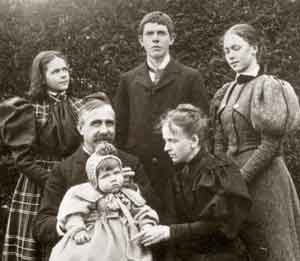
The rich history of The Mountaineers Kitsap Property began on a Spring day in 1909. A 'local walk' to view the wild blooming rhododendrons around Wildcat Lake began one of The Mountaineers most enduring traditions. The 'misguided' group of 66 Mountaineers wandered into Hidden Valley Ranch and met Edward Paschall and his family. A fast friendship was forged on that day. Mountaineers would return regularly to the area for the next 100+ years. Suzanne Gerber of The Mountaineers wrote about our history in The Mountaineer Magazine in 2014.
The Rhododendron Preserve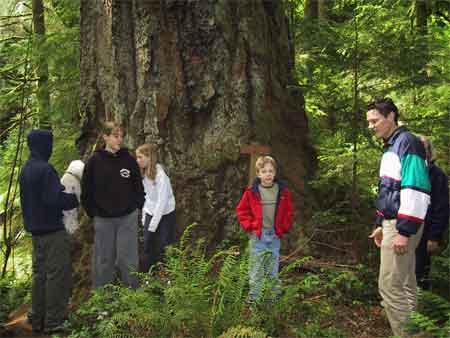
Through the efforts of Mountaineer Peter McGregor and Peter Paschall, The Mountaineers purchased 74 acres of hill land next to Hidden Valley in 1915. The 'Rhododendron Park' was intended as a place for Mountaineers to visit and enjoy and to preserve the natural beauty of the area. Over the years, members would buy tracts of property nearby for their own use. Members would build small cabins to enjoy during their visits. The park had 409 registered visitors in its first 6 months at a time when the club boasted a membership of only 400. The preserve grew in size over the years to almost 200 acres through member donations and property acquisition. In 1985, The Mountaineers Club transferred ownership of 170 acres to The Mountaineers Foundation - at that time closely affiliated with The Mountaineers, for preservation and study while keeping historical access and use the same as before the transfer. Since then the foundation changed its name to the KETA Legacy Foundation and the focus has changed for the foundation. The club retained ownership of the 20 acres that contain Kitsap Cabin and the Kitsap Forest Theater. The Foundation has since purchased buffer property and increased the size of the preserve to over 460 acres.
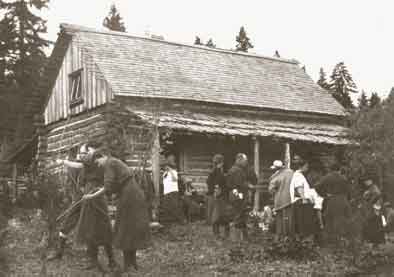
Kitsap Cabin
The original 74 acre purchase contained a log cabin and several outbuildings. The old Gilson farmstead was a two-story log building that served as the original Kitsap Cabin. The men slept in the barn, the women upstairs in the old house and couples in three chicken houses. The main house was described as a "weather-beaten, decrepit relic of some early settlers losing fight to conquer the stony soil." The Mountaineers recognized that it wouldn't suffice for a lodge much longer. They began seriously to dream of a new cabin.
The new Kitsap cabin was constructed in 1918 during World War I. The war effort had taken away most of the males, so mostly women volunteers did the bulk of the construction work. The fireplace was designed with a niche above the mantle for a plaque honoring Mountaineers who died during the war. The niche remains empty to this day as none were killed.
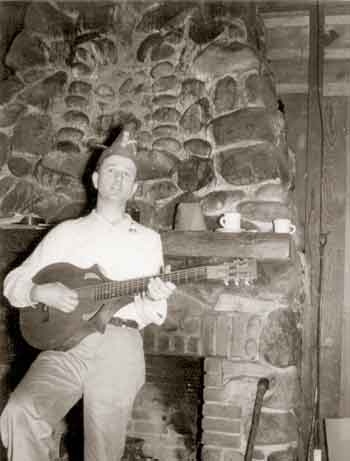 The cost of the new cabin was $600. The low cost was attributed to C.G. Morrison, a building consultant who helped the Mountaineers secure the best building materials at the best prices. It was estimated that the cabin would have cost $2,500 if all materials and labor had been purchased.
The cost of the new cabin was $600. The low cost was attributed to C.G. Morrison, a building consultant who helped the Mountaineers secure the best building materials at the best prices. It was estimated that the cabin would have cost $2,500 if all materials and labor had been purchased.
The new cabin, consisting of a kitchen, common area, and a large stone fire place was dedicated by Mountaineers president Edmund Meany on November 23, 1918, just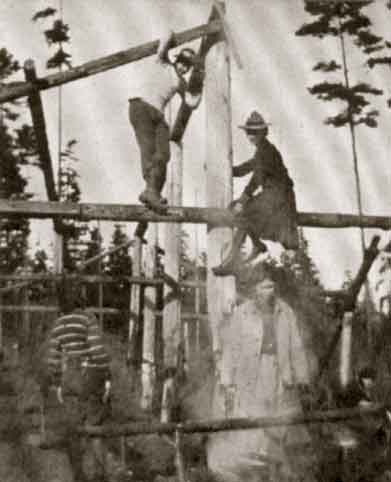 days after the war ended. The common area of the cabin was enlarged in 1927 with the help of noted architect Elsworth Story.
days after the war ended. The common area of the cabin was enlarged in 1927 with the help of noted architect Elsworth Story.
In 2000 The Mountaineers condemned the property because of an unsafe foundation. The Mountaineers Players, knowing that the show must go on, worked with Jamie Gordon and The Mountaineers Foundation to raise the necessary money (and get Historical designation for the cabin and theater) so that the foundation could be rebuilt and other improvements could be made. You can read about that endeavor here.
In 2012-2013, thanks to the Altwein grant, additional improvements were made to Kitsap Cabin - including updating the kitchen. The kitchen floor was totally replaced (from the joists) and replaced with tile. A new custom stainless steel sink island was built, and other surfaces replaced with stainless steel. A professional stove hood/fan was installed. Many, many hours of work by both professionals and volunteers completed this project between show seasons. Our volunteer cooks are loving the new kitchen!
The Mountaineers Players & Kitsap Forest Theater
A prominent activity among early Mountaineers visitors involved dramatic diversions. Skits, pantomimes, kangaroo-courts, and mock-weddings were performed using props and costumes at hand. The first theatrical effort that had any continuity was a pantomime staging of the Legend of Sleepy Hollow in 1916. The headless horseman rode on a bright, moonlit Halloween night. The actors wore sheets and rode sticks with carved horses heads. The skits and performances grew into a released production of Robin of Sherwood on June 17, 1923.
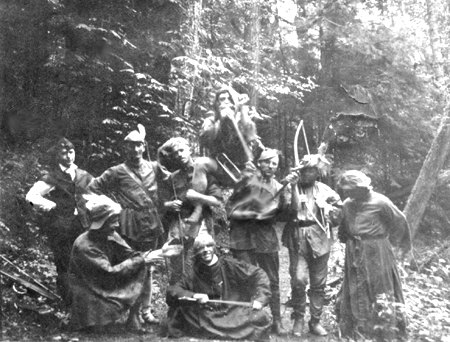 The audience moved from clearing to clearing as different scenes were presented. The performance marked the birth of The Mountaineers Players who went on to produce an annual spring show on the property every year to the present day, the only exception being four years during World War II.
The audience moved from clearing to clearing as different scenes were presented. The performance marked the birth of The Mountaineers Players who went on to produce an annual spring show on the property every year to the present day, the only exception being four years during World War II.
The early shows were staged in several clearings on the property.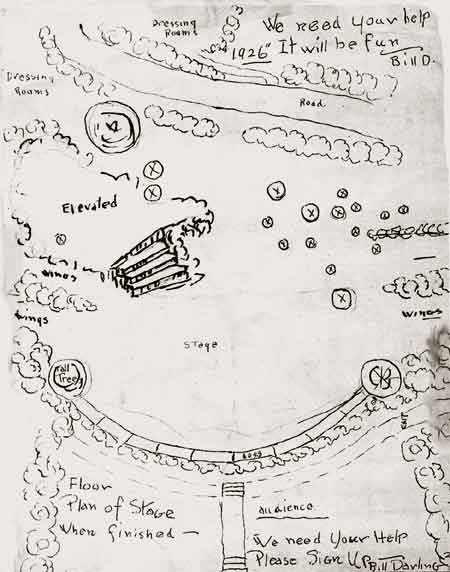 The increasing size of the audience and the relatively uncomfortable accommodations (standing in a moist bog while swatting mosquitoes) spurred the movement to build a permanent theater facility. William C. Darling and the Players business manager Claire McGuire scouted the site of the present day Kitsap Forest Theater. The site was a level spot with a gentle upward slope near Chico Creek. The Mountaineers felled trees, carved terraced seats in the hillside and lugged cedar bark from the creek bottom under Mr. Darling's direction. The original design of the theater attempted to recreate a naturally occurring glade in the forest. Trees were thinned to allow streams of light to fall on the stage while keeping the audience shaded. Wings were constructed out of cedar bark covered with moss. Modernizations such as running water, electricity, and several buildings for storage and dressing have been added but the original design and concept remain the same. A lush
The increasing size of the audience and the relatively uncomfortable accommodations (standing in a moist bog while swatting mosquitoes) spurred the movement to build a permanent theater facility. William C. Darling and the Players business manager Claire McGuire scouted the site of the present day Kitsap Forest Theater. The site was a level spot with a gentle upward slope near Chico Creek. The Mountaineers felled trees, carved terraced seats in the hillside and lugged cedar bark from the creek bottom under Mr. Darling's direction. The original design of the theater attempted to recreate a naturally occurring glade in the forest. Trees were thinned to allow streams of light to fall on the stage while keeping the audience shaded. Wings were constructed out of cedar bark covered with moss. Modernizations such as running water, electricity, and several buildings for storage and dressing have been added but the original design and concept remain the same. A lush 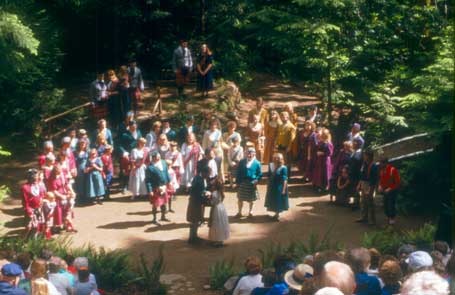 row of fern footlights, bark covered wing walls with living moss and rhododendrons and dogwoods filling the back drop are just a few of the natural wonders of this unique space.
row of fern footlights, bark covered wing walls with living moss and rhododendrons and dogwoods filling the back drop are just a few of the natural wonders of this unique space.
The Mountaineers Players are one of the oldest, continuously operating community theater groups in the country, performing in one of the oldest outdoor theaters in North America. The Players pride themselves on the family-orientation of their program. It is not uncommon for several generations of families to be involved in producing the show. Several current active members have participated since the 1950s (update: most of these Players have sadly passed).
 For many Mountaineers, the Kitsap Property is a place where a work ethic still prevails and people of all ages have respect for each other and their contributions. Multi-generational friendships endure. We hope that new generations will find satisfaction in play and work well done, and that theatergoers will continue to enjoy the truly unique experience of the Theater in The Wild.
For many Mountaineers, the Kitsap Property is a place where a work ethic still prevails and people of all ages have respect for each other and their contributions. Multi-generational friendships endure. We hope that new generations will find satisfaction in play and work well done, and that theatergoers will continue to enjoy the truly unique experience of the Theater in The Wild.
Rhododendron Preserve and the Mountaineers Players
Gardner Hicks has written an article about his thoughts about the one time symbiotic relationship between The Mountaineers Foundation Rhododendron Preserve and The Mountaineers Players/Kitsap Forest Theater that was published in The Mountaineers Magazine. You can read it here.
Theatre In The Wild
Theatre in the Wild, A Pictorial History of The Mountaineers Forest Theater is a wonderful telling of the history of the Rhododendron Preserve, Kitsap Cabin and the Kitsap Forest Theatre. It is for sale at the info booth during shows and the stories are included on the individual show pages found here. Much of the content on older past shows are based up this history.
Present Day
Please contact us if you would like to participate behind the scenes or on stage. We welcome all ages to become involved.
